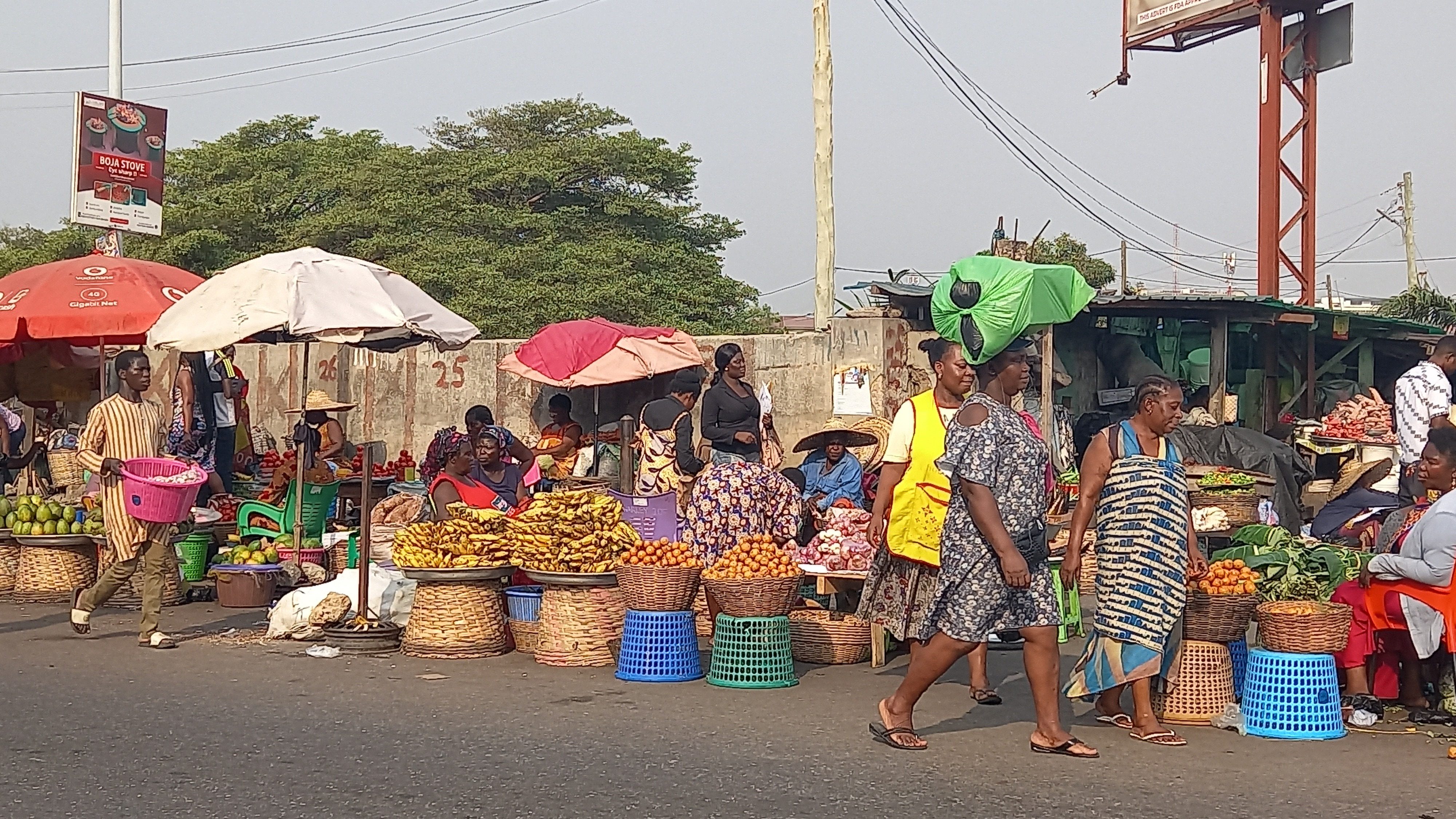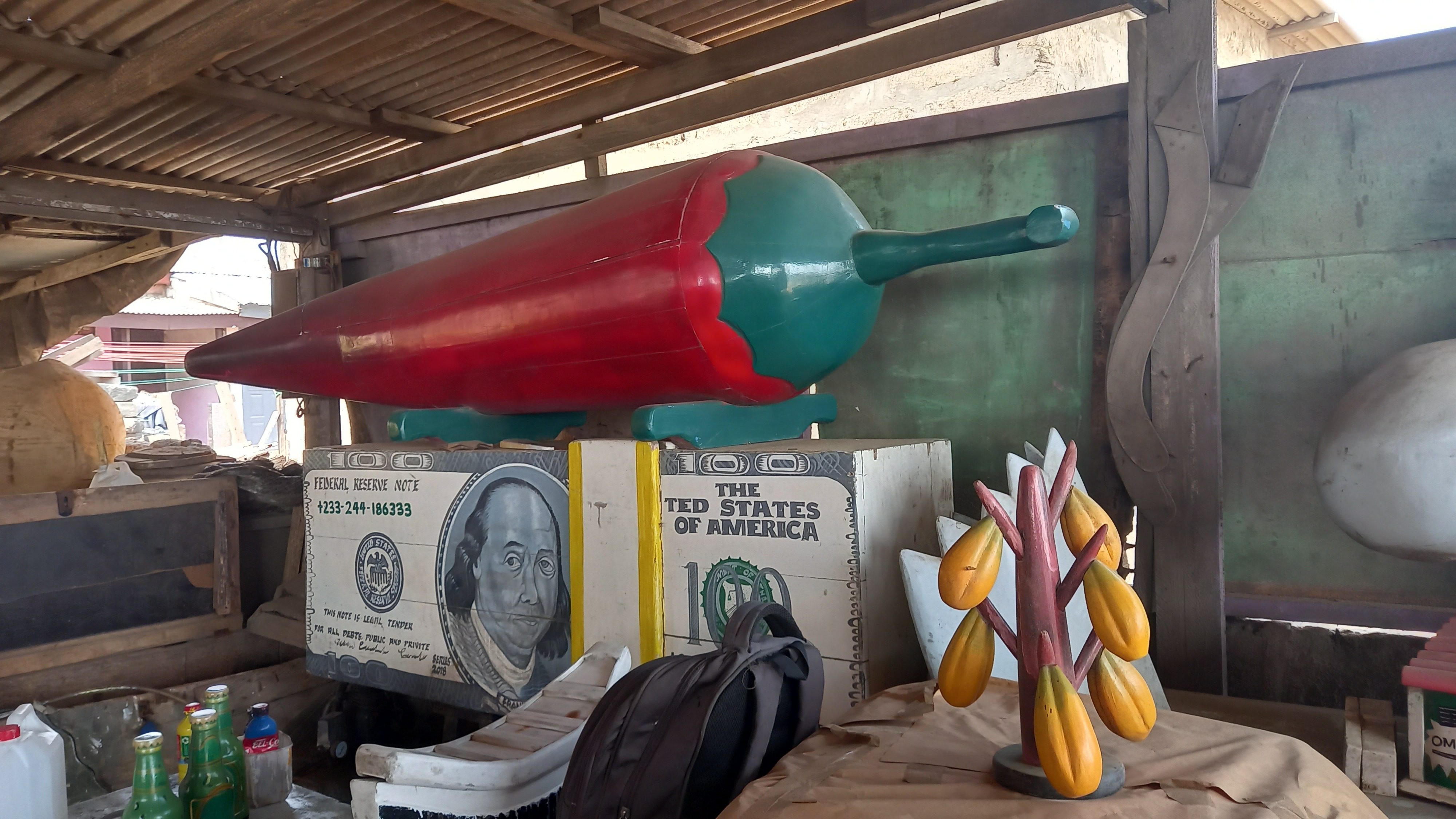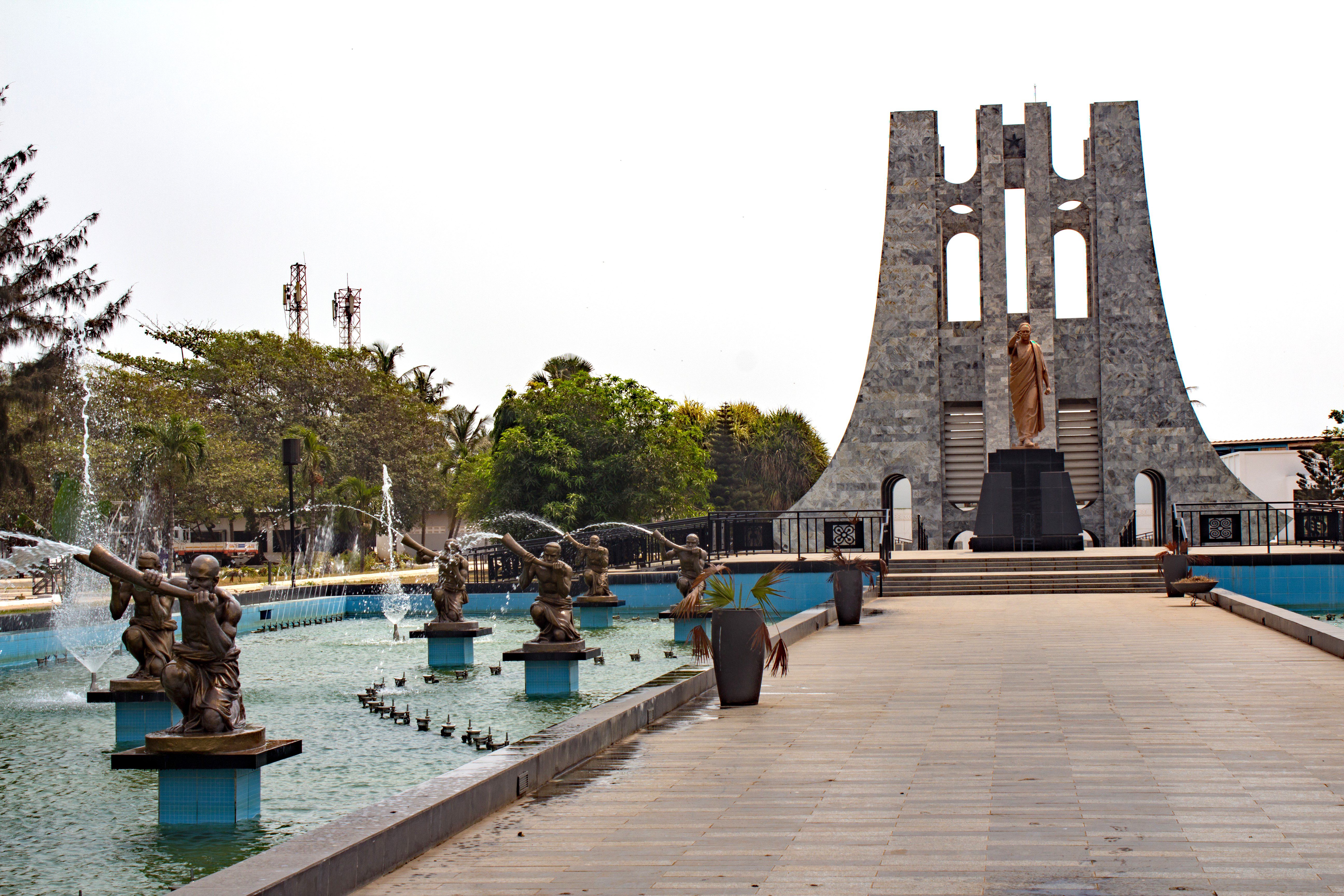Whilst staying in Ghana’s capital Accra, we enjoyed a full day’s sightseeing. The city is not particularly walkable and as we drove through the streets, I enjoyed spotting the wonderfully religious themed shop names designed to demonstrate their faith: Believe in God Vulcanising Shop; God’s time is the Best Enterprise; Arise and Shine Beauty Salon; and Give Thanks to God Store.
MAKOLA MARKET
Accra’s largest open-air market, established in 1924, has been the city’s commercial core for a century and is still the country’s main trade hub.
Before immersing ourselves in the throng, we were told to listen out for the word ‘agoo’ which in the local Akan language means ‘pay attention or listen’. It would be used by porters carrying heavy loads on their heads when they wanted you to move out of their way, or by stallholders wanting your attention, when the reply should be ‘amee’ meaning ‘I am listening’.
The streets leading to the market were lined with stalls selling a huge range of goods: fruit and vegetables, including mounds of red and green scotch bonnet as Ghanaian’s love spicy food; pigs trotters and curls of cow skin called ponmo; dried fish and shrimps; household goods and cleaning products; shoes and clothing; mobile phone cases; traditional colourful material; jewellery; and lots and lots of wigs and false hair pieces. My favourite sight was a lady with a head and wig balanced on her head, but we’d been told not to photograph people. In contrast to the noisy, messy streets, the actual indoor market was clean and organised and unlike in many markets we’ve visited, there was no hassle.
BLACK STAR GATE AND INDEPENDENCE SQUARE
In the middle of a huge roundabout, which was surprisingly easy to cross, was Black Star Arch which we were able to walk up (60+ steps). Commissioned by Ghana’s first president, Kwame Nkrumah, to celebrate independence in 1957, it was completed in 1961 for the state visit of Queen Elizabeth II. The Black Star of Africa sat on top, and below were the words AD 1957 Freedom and Justice. At the top, someone had helpfully left a Ghanaian flag with red, yellow and green horizontal stripes with a central black star, which we held aloft for a good photo opportunity. There were views of Independence Square, which could accommodate 30,000 people in eight seating stands, but it was pretty bleak and desolate apart from the Memorial of the Tomb of the Unknown Soldier and eternal flame, symbolizing the Ghanaians who lost their lives fighting for independence from the British.
ARTISTS ALLIANCE GALLERY
The gallery, established as Glo Art Gallery in 1968 by a Ghanaian artist, Ablade Glover, was renamed the Artists Alliance Gallery in 1993. Works of 30+ artists were showcased over three floors in a beautiful building overlooking the ocean. Artefacts included paintings, carvings, furniture, jewellery, fabrics and photography and it was lovely to be left to our own devices and wander, although disappointingly, but understandably, photographs were not allowed.
KWAME NKRUMAH MEMORIAL PARK AND MAUSOLEUM
The Kwame Nkrumah Memorial Park and Mausoleum was located in downtown Accra, on a former British whites-only polo ground and was where Ghana’s first President, formally declared independence on 6 March 1957. Although opened in 1992, a plaque at the entrance commemorated a recent refurbishment in July 2023. Inside the impressive hall, was a large American car, a gift from President Kennedy, and here we joined a group for the mandatory tour.
In the gardens we were given a potted history of Nkrumah: his birth place; two wives (the first was half Ghanaian and half British, whilst the second, Fathia, was Egyptian); children (one to wife number one, and three to the second); and his death following treatment for an undisclosed ailment in Romania. The extensive grounds had several trees with wooden plaques commemorating VIP visits.
The mausoleum, designed by Don Arthur, a young Ghanaian architect, was clad in Italian marble, with a black star at the apex symbolising unity. Here Nkrumah was buried, surrounded by river-washed rocks, for the third time, having originally being buried in Guinea and then Nkroful, the village of his birth, before being moved to its final resting place in the mausoleum along with his wife, Fathia. In front a long pool was adorned with brass musicians with water spouting from horns, musical fountains and other statues.
Outside the museum stood a statue of Nkrumah which had lost its head when toppled in a military coup in 1966: the head was now placed by the side. A Freedom Wall with famous quotes and pictures depicted Nkrumah in different states of emotions.
There were two parts to the museum, but unfortunately photos were not allowed in either. The first had more quotes on the walls and black and white photos of Nkrumah along with notable people, including Queen Elizabeth II – if you’ve watched The Crown (Season 2 Episode 8), you’ll recall a famous scene when the two danced. The second part, designed to be self-guided, was devoted to four stages of Nkrumah’s life with personal effects, including his desk, clothes, piano, and more photos including one taken with Cassius Clay in front of his statue, which at the time had head and body combined.
JAMESTOWN
Jamestown is said to be one of the oldest and most characterful parts of the city, where our local guide provided a brief history of the area as we wandered through narrow lanes. Each of the family homes housed the extended family as Ghanaians believe that if your parents have looked after you for so many years, you should reciprocate. The homes were very closely packed to allow them to quickly call on neighbours for help. Once again, we were told not to photograph people, but having snapped an interesting wall with birds, the owner shook her fist at us. It all felt a bit seedy and run down, with lots of mess and litter, men laid around and women lounging in chairs. Posters of funeral arrangements for the departed never appeared to be removed and remained despite many intervening years. We paused in the shade, where music was playing and were told that the words were statements about colonial rule. At a huge community space, we found a boxing gym, basketball court and local theatre, whilst across on the coast road, stood a red and white striped lighthouse and St James fort, a UNESCO sight that was run down, closed and hard to photograph.
TESHIE NUNGUA – FANTASY COFFINS “OKADI ADEKAI”
Ghanaian funeral ceremonies are solemn occasions, but after the burial a celebration follows. They believe the departed move on into another world and that the design of the coffin is very important.
In Teshie Nungua, a small town on Accra’s outskirts, we found the Erico Carpentry Workshop. Here our host showed us his display of colourful fantasy coffins designed to reflect the interests of, or occupation of the deceased. These included: an aircraft for a pilot, a sneaker, Nokia phone, bull for a farmer, red chilli pepper, crab, and a bottle of Ghanaian Club beer.
Erico told us that the coffins are made in a standard size of 6 feet, as Ghanaians are not very tall, and cost around $8,000, depending on the complexity of the design, so only the rich can afford such a sendoff.
Coffins typically take around 3 months to carve, but there is no particular rush as funerals can be some time after the death, with the body being kept in the mortuary until burial. When there is an unexpected death, some coffins can be finished in two weeks if there is inducement for an expedited job.
The coffins are generally made from soft and light coloured wawa wood, but if they are to be exported, they will be in a harder limba or mahogany wood. Erico produces around 24 coffins a year and he showed us his work in progress: a church and a spanner for a mechanic.
On leaving, we debated what design we would choose, and I decided that I’d like to be buried in a bottle of Sauvignon Blanc.
W E B DU BOIS CENTRE
In contrast to the other sights, we could walk to the W E B Du Bois Centre from our hotel, although it was a hot 20-minute hike. We paid just over £1 each and rejected the offer of a guide. The centre, which had been Du Bois house, was relatively small, and information displays were all in English and easy to understand. In a small room to the side, which we hoped would be a café, a guy opened up and showed us what looked like the tomb covered with artificial flower wreaths surrounding it. There was also a small gift shop at the entrance, before setting off for the walk back, we enjoyed a reviving cold drink in Roots bar, behind the centre.












